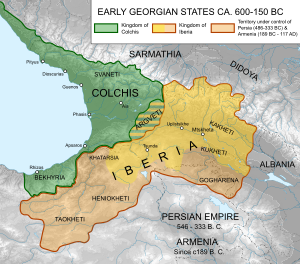Kolchis

Kolchis (georgisk: კოლხეთი, k'olxeti, gammelgresk: Κολχίς) var et gammelt georgisk kongedømme og en region[1][2][3][4][5][6] i den vestlige delen av dagens Georgia, som spilte en viktig rolle i den etniske og kulturelle dannelsen av den georgiske nasjon og dens undergrupper.[7][8]
Som en georgisk statsdannelse, bidro Kolchis betydelig i utviklingen av middelalderens georgiske statsdannelse, etter å ha opprettet en union med Kaukasisk Iberia.[9][10][11] Benevnelsen kolshisianere brukes også som fellesbenevnelse på de tidlige georgiske stammene som befolket østkysten av Svartehavet.[12]
I gresk mytologi var Kolchis hjemlandet til kong Aietes og hans datter Medeia, og stedet er kjent fra myten om Jason og argonautenes reise til Kolchis for å hente det gylne skinn. Det er også det mulige hjemlandet til de mytiske amasonene. Kongedømmets område omfatter idag de georgiske provinsene, Abkhasia, Mingrelia, Svaneti, Racha, Imereti, Guria, Adsjaria, Rize, Trabzon, Artvin og de tyrkiske provinsene.[13]
Kolshisianerne bebodde muligens Kaukakus i midten av bronsealderen.[14]
Verdensarv
[rediger | rediger kilde]Regnskogs- og våtmarksområdene i Kolchis ble i 2021 oppført på UNESCOs verdensarvliste.[15]
Referanser
[rediger | rediger kilde]- ^ Georgia in Antiquity: A History of Colchis and Transcaucasian Iberia, 550 BC-AD 562, David Braund Oxford: Clarendon Press, 1994. s. 359
- ^ The Making of the Georgian Nation, Ronald Grigor Suny, s. 13
- ^ Modern Hatreds: The Symbolic Politics of Ethnic War, Stuart J. Kaufman, s. 91
- ^ Cyril Toumanoff, Studies in Christian Caucasian History, s. 69
- ^ One Europe, Many Nations: A Historical Dictionary of European National Groups, James Minahan, s. 282
- ^ Marc Van de Mieroop, A History of the Ancient near East, C. 3000–323 BC, s. 265
- ^ Charles Burney and David Marshal Lang, The Peoples of the Hills: Ancient Ararat and Caucasus, s. 38
- ^ Oliver Wardrop, The Kingdom Of Georgia: Travel In A Land Of Women, Wine And Song (Kegan Paul Library of History and Archaeology)
- ^ Modern Hatreds: The Symbolic Politics of Ethnic War, Stuart J. Kaufman, s. 91
- ^ David Braund, Georgia in Antiquity: A History of Colchis and Transcaucasian Iberia, 550 BC-AD 562, Oxford University Press, USA (September 8, 1994)
- ^ W.E.D. Allen, A history of the Georgian people (1932), s. 123
- ^ The Great Soviet Encyclopedia:Значение слова "Колхи" в Большой Советской Энциклопедии
- ^ Andrew Andersen, History of Ancient Caucasus, s. 91
- ^ David Marshal Lang, the Georgians, Frederich A. Praeger Publishers, New York, s. 59
- ^ «Colchic Rainforests and Wetlands». whc.unesco.org. UNESCO. Besøkt 28. januar 2025. «The property comprises seven component parts, within an 80km long corridor along the warm-temperate and extremely humid eastern coast of the Black Sea. They provide a series of the most typical Colchic ecosystems at altitudes ranging from sea level to more than 2,500 metres above it. The main ecosystems are ancient deciduous Colchic rainforests and wetlands, percolation bogs and other mire types of the distinct Colchic mire region. The extremely humid broad-leaved rainforests comprise a highly diverse flora and fauna, with very high densities of endemic and relict species, with significant numbers of globally threatened species and relict species, which survived the glacial cycles of the Tertiary. The site is home to approximately 1,100 species of vascular and non-vascular plants, including 44 threatened vascular plan species, and almost 500 species of vertebrates, and a high number of invertebrate species. The site also harbours 19 threatened animal species including sturgeon, notably the critically endangered Colchic Sturgeon. It is a key stopover for many globally threatened birds that migrate through the Batumi bottleneck.»
